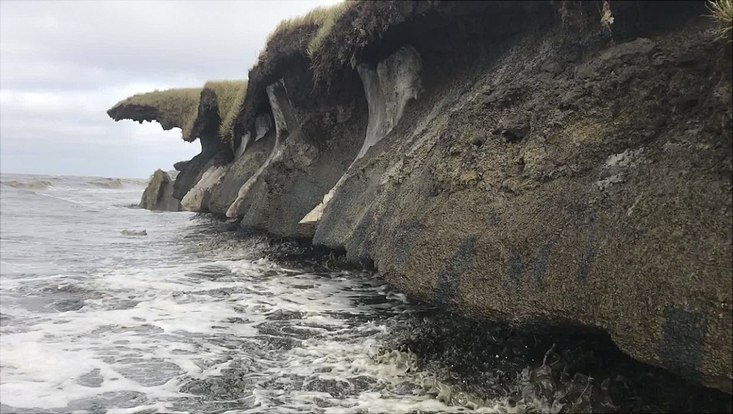and Society (CLICCS)
Land loss due to climate hazards in Alaska"This study is a wake-up call"
4 December 2024, by Woods Hole Oceanographic Institution (WHOI)

Photo: Benjamin M. Jones, Institute of Northern Engineering, University of Alaska Fairbanks
The overlapping effects of sea level rise, permafrost thaw subsidence, and erosion may lead to land loss in Arctic coastal regions that dwarfs the land loss from any single one of these climate hazards, scientists say.
While 75 years of aerial and satellite observations have established coastal erosion as an increasing Arctic hazard, other hazards—including the cumulative impact of sea level rise and permafrost thaw subsidence, have received less attention. This has prevented assessments of the impacts these processes have compared to and combined with coastal erosion.
A new study in Proceedings of the National Academy of Sciences by scientists with the Woods Hole Oceanographic Institution (WHOI), the Cluster of Excellence "Climate, Climatic Change, and Society" (CLICCS) at the University of Hamburg, and other academic institutions focuses on Alaska’s Arctic Coastal Plain (ACP), a 60,000+ square kilometer, low-elevation, and low-relief landscape replete with ice-rich permafrost that has among the highest rates of sea-level rise and coastal erosion in the Arctic.
“Our findings highlight the risks that compounding climate hazards pose to coastal communities and underscore the need for adaptive planning for Arctic communities within zones of 21st-century land loss,” the study notes.
“Compound climate impacts accelerate coastal change,” said study lead author Roger Creel, a postdoctoral scholar in WHOI’s Department of Physical Oceanography. “There is this nonlinear acceleration in coastal impacts that we should be expecting will happen in places like Northern Alaska.”
“Not only will the combined impact of erosion, sea-level rise and soil subsidence reshape the Alaskan landscape, the marine environment will also dramatically change,” said co-author David Nielsen, postdoctoral researcher at the Cluster of Excellence for Climate, Climatic Change, and Society (CLICCS) at the University of Hamburg, Germany. “We estimated that this combination of processes could mobilize 8-11 times more carbon from land into water bodies than what would be expected from coastal erosion alone. The magnitude of this combined impact on coastal ecosystems remains uncertain.”
“The findings from this study reveal an unprecedented transformation of Alaska’s Arctic coastlines. By 2100, the combined effects of coastal erosion, sea level rise, and permafrost thaw subsidence will likely push the North Slope shoreline inland to a location it hasn't reached since the last interglacial period over 100,000 years ago,” said study co-author Benjamin Jones, research associate professor at the Institute of Northern Engineering, the University of Alaska Fairbanks. “These findings represent a paradigm shift in the 21st Century Arctic, highlighting the urgent need for adaptive strategies to protect vulnerable communities and infrastructure in the face of these cumulative climate hazards.”
The study utilized 5-meter topography, satellite-derived coastal lake depth estimates, and empirical assessments of land subsidence due to permafrost thaw, along with projections of coastal erosion and sea level rise for medium and high emission scenarios from the IPCC’s 6th Assessment Report.
“This research highlights the value of working across disciplinary boundaries for more robust projections of coastal Arctic evolution in the coming century,” said co-author Julia Guimond, assistant scientist in WHOI’s Applied Ocean Physics and Engineering Department. “Our work shows that By 2100, total land loss will exceed erosional losses by up to eight times. Here we focus on processes affecting Alaska's Arctic Coastal Plain, but a key takeaway is the compounding effects of multiple hazards and that applies to coastal resilience planning across the globe.”
“Along ice-rich permafrost coastlines, the land surface is falling faster than the sea levels are rising. Over the coming decades, permafrost thaw subsidence will move the coastline farther inland than coastal erosion or sea level rise alone will move it, and this subsidence will dominate Arctic coastal change over the long term,” said co-author Paul Overduin, senior scientist at the Alfred Wegener Institute Helmholtz Centre for Polar and Marine Research in Potsdam, Germany.
Creel said the impact of permafrost thaw subsidence is familiar to people who live in northern Alaska. However, he adds agencies such as the U.S. Army Corps of Engineers and the Federal Emergency Management Agency allocate many of their resources based on published literature. “These sorts of bodies with a lot of resources may have not been paying enough attention to permafrost thaw subsidence as an agent of coastal change. This study is a wake-up call to expand the conversation.”
An Arctic shoreline governed by inundation “will pose new challenges to communities whose homelands – including infrastructure, hunting grounds, subsistence access routes, cultural heritage sites, landscapes, and the soil itself – are disappearing,” the study states. “Future research on Arctic shoreline evolution should be motivated by the needs of these communities, who will need support to respond to the paradigm shift in 21st century Arctic coastal change that we project here.”
Further Information
Publication
Creel R, Guimond J, Jones B, Nielsen D, Bristol E, Tweedie C, Overduin P (2024): Permafrost thaw subsidence, sea-level rise, and erosion are transforming Alaska’s Arctic coastal zone. Proceedings of the National Academy of Sciences, DOI: 10.1073/pnas.2409411121
Images and video available for use with credit to WHOI can be found here.
Contact
Dr. David Nielsen
University of Hamburg
Cluster of Excellence "Climate, Climatic Change, and Society" (CLICCS)
Max-Planck-Institute for Meteorology
E-Mail: david.nielsen"AT"uni-hamburg.de


